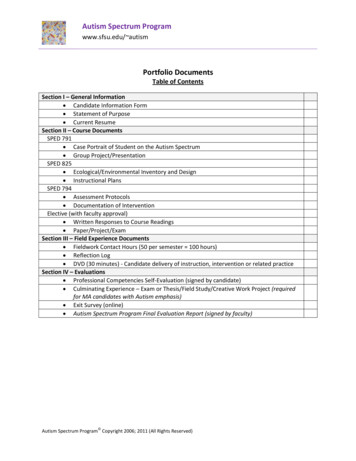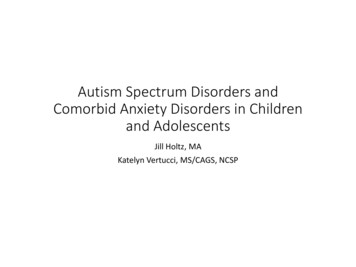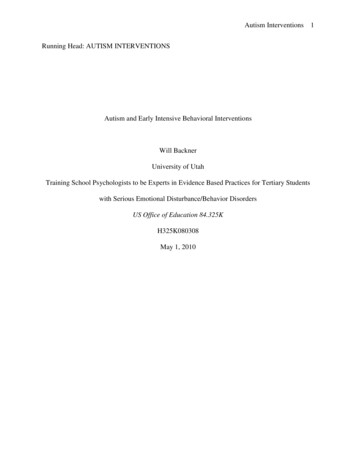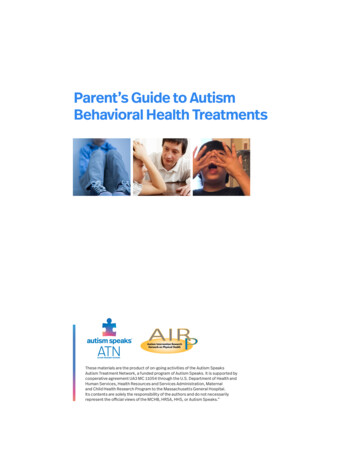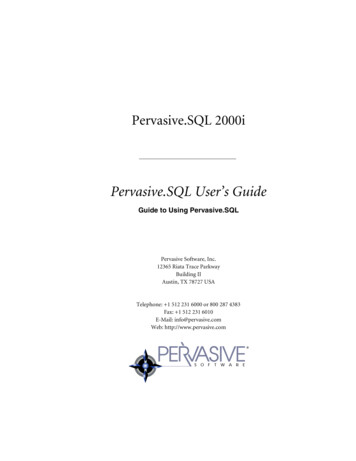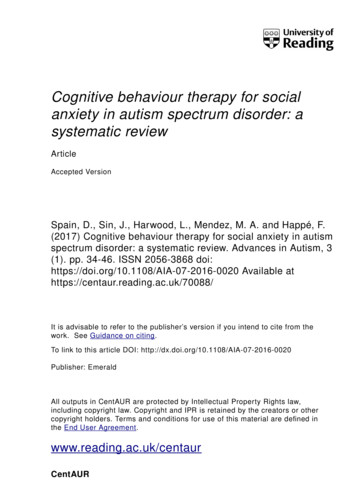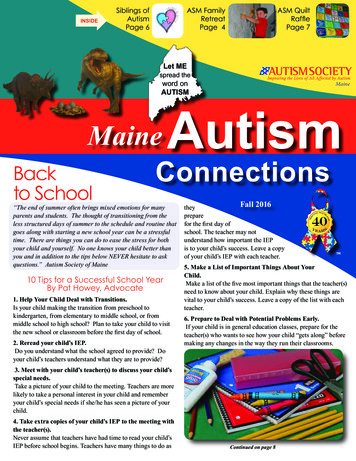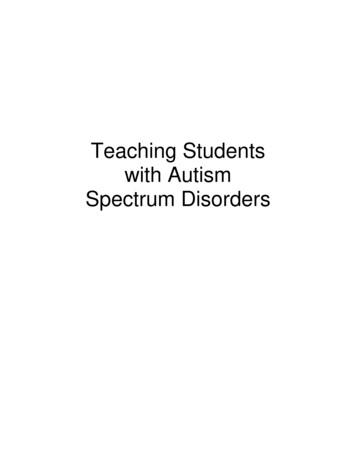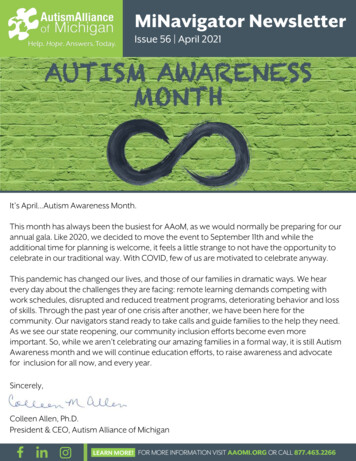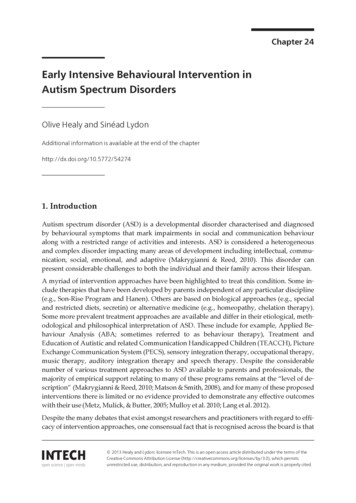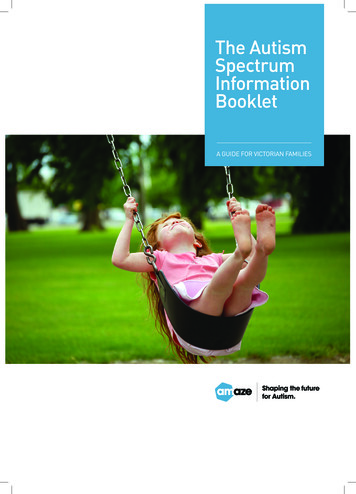
Transcription
Medical Coverage PolicyEffective Date .12/15/2021Next Review Date.12/15/2022Coverage Policy Number . 0447Autism Spectrum Disorders/PervasiveDevelopmental Disorders: Assessment andTreatmentTable of ContentsRelated Coverage ResourcesOverview .2Coverage Policy.2General Background .4Medicare Coverage Determinations .22Coding/Billing Information .23References .29AcupunctureBiofeedbackChelation TherapyCognitive RehabilitationComparative Genomic Hybridization(CGH)/Chromosomal Microarray Analysis (CMA)for Selected Hereditary ConditionsComplementary and Alternative MedicineGenetic Testing for Hereditary and MultifactoralConditionsGenetic Testing for Reproductive Carrier Screeningand Prenatal DiagnosisHyperbaric and Topical Oxygen TherapiesIntensive Behavioral InterventionsNeuropsychological TestingOccupational TherapySensory and Auditory Integration Therapy - FacilitatedCommunicationSpeech Generating DevicesSpeech Therapy.INSTRUCTIONS FOR USEThe following Coverage Policy applies to health benefit plans administered by Cigna Companies. Certain Cigna Companies and/or lines ofbusiness only provide utilization review services to clients and do not make coverage determinations. References to standard benefit planlanguage and coverage determinations do not apply to those clients. Coverage Policies are intended to provide guidance in interpretingcertain standard benefit plans administered by Cigna Companies. Please note, the terms of a customer’s particular benefit plan document[Group Service Agreement, Evidence of Coverage, Certificate of Coverage, Summary Plan Description (SPD) or similar plan document] maydiffer significantly from the standard benefit plans upon which these Coverage Policies are based. For example, a customer’s benefit plandocument may contain a specific exclusion related to a topic addressed in a Coverage Policy. In the event of a conflict, a customer’s benefitplan document always supersedes the information in the Coverage Policies. In the absence of a controlling federal or state coveragemandate, benefits are ultimately determined by the terms of the applicable benefit plan document. Coverage determinations in each specificinstance require consideration of 1) the terms of the applicable benefit plan document in effect on the date of service; 2) any applicablelaws/regulations; 3) any relevant collateral source materials including Coverage Policies and; 4) the specific facts of the particularsituation. Each coverage request should be reviewed on its own merits. Medical directors are expected to exercise clinical judgment andhave discretion in making individual coverage determinations. Coverage Policies relate exclusively to the administration of health benefitplans. Coverage Policies are not recommendations for treatment and should never be used as treatment guidelines. In certain markets,delegated vendor guidelines may be used to support medical necessity and other coverage determinations.Page 1 of 35Medical Coverage Policy: 0447
OverviewThis Coverage Policy addresses services for the assessment and treatment of autism spectrum disorders andpervasive developmental disorders.Coverage PolicyA number of states have coverage mandates that require regulated benefit plans to cover servicesrelated to an autism spectrum disorder (ASD) or pervasive developmental disorder (PDD). For example,New York law requires regulated benefit plans to provide coverage for the screening, diagnosis andtreatment of ASD/PDD.Please refer to the applicable benefit plan document to determine terms, conditions and limitations ofcoverage.Coverage for speech generating devices varies across plans. Refer to the customer’s benefit plandocument for coverage details. Many benefit plans exclude coverage for “aids or devices that assist withnonverbal communications”. When this language is present in the benefit plan, speech generatingdevices that use prerecorded messages (HCPCS codes E2500-E2506) are not covered. However, unlessspecifically excluded, speech generating devices that use synthesized speech are covered if criteria aremet. When covered, coverage for speech generating devices is subject to the terms, conditions andlimitations of the applicable benefit plan’s Durable Medical Equipment (DME) benefit and schedule ofcopayments.Services provided by a psychiatrist, psychologist or other behavioral health professionals may besubject to the provisions of the applicable behavioral health benefit.Assessment and treatment for comorbid behavioral health and/or medical diagnoses and associatedsymptoms and/or conditions may be covered under applicable medical and behavioral health benefitplans.Coverage of medications related to the treatment of Autism Spectrum Disorder (ASD) may be subject tothe pharmacy benefit portion of the applicable benefit plan.AssessmentThe following services are considered medically necessary for the assessment of a suspected or knownASD: audiological evaluationbehavioral health evaluation including psychiatric examinationelectroencephalogram (EEG) when there is suspicion of a seizureevaluation by speech and language pathologistlead screeningmedical evaluation including history and physical examinationautism-specific developmental screening (Current Procedural Terminology [CPT] code 96110, e.g.,Checklist for Autism in Toddlers [CHAT], Pervasive Developmental Disorder Screening Test-II) and CPTcodes 96112, 96113, e.g., Autism Behavior Checklist [ABC], Childhood Autism Rating Scale [CARS])neuroimaging studies when the child is a candidate for specific interventions such as epilepsy surgeryoccupational and/or physical therapy evaluation when motor deficits, motor planning or sensorydysfunction are presentquantitative plasma amino acid assays to detect phenylketonuriawhen ANY of the following criteria are met:Page 2 of 35Medical Coverage Policy: 0447
any loss of any language or social skills at any ageabsence of babbling by 12 monthsabsence of gesturing (e.g., pointing, waving bye-bye) by 12 monthsabsence of single word speech by 16 monthsabsence of 2-word spontaneous (not echolalic) phrases by 24 monthsTreatmentBehavioral health treatment (e.g., behavior modification, family therapy, cognitive behavioral therapy orother forms of psychotherapy) for ASD is considered medically necessary when ALL of the followingcriteria are met: individual meets criteria for ASD in the Diagnostic and Statistical Manual of Mental Health Disorders,Fifth Edition (DSM-5)services are appropriate in terms of type, frequency, extent, site and durationtreatment is being provided by an appropriate behavioral health care professionalmeaningful and measurable improvement is expected from the therapyPlease refer to the Medical Coverage Policy on Intensive Behavioral Interventions for specific medicalnecessity criteria for applied behavior analysis (ABA).Please refer to the Medical Coverage Policies on Neuropsychological Testing, Speech Therapy,Occupational Therapy, Physical Therapy and the Cigna/ASH Medical Coverage Policy for Sensory andAuditory Integration Therapy - Facilitated Communication for specific coverage criteria for theseservices.Speech Generating DeviceA speech generating device for ASD is considered medically necessary when ALL of the followingcriteria are met: The individual has a permanent and severe expressive speech impairment.A speech evaluation, conducted by a speech-language pathologist, has documented the severity of theindividual’s disability, specific to their primary language.Speaking needs cannot be met using natural communication methods.Other forms of treatment have failed, are contraindicated, or are otherwise not appropriate.A speech generating device is available in the individual’s primary languageA speech generating device is being requested for the sole purpose of speech generation.Not Medically Necessary ServicesServices that are considered primarily educational or training in nature or related to academic or workperformance are not covered under many benefit plans. The following services for the assessmentand/or treatment of ASD are considered primarily educational and training in nature and not medicallynecessary: education and achievement testing, including Intelligence Quotient (IQ) testingeducational interventions (e.g., classroom environmental manipulation, academic skills training andparental training)Multi-purpose, general consumer electronic devices such as personal digital assistants (PDAs),computers, tablet devices (e.g., iPads ), smart phones, electronic mail devices and pagers, are notmedical in nature and thus are considered not medically necessary.Page 3 of 35Medical Coverage Policy: 0447
Experimental, Investigational or UnprovenThe following procedures/services for the assessment and/or treatment of ASD are consideredexperimental, investigational or unproven for this indication:Assessment: allergy testing (e.g., food allergies for gluten, casein, candida, molds) blood metabolite testing (e.g., NPDX ASD test) celiac antibodies testing central carbon metabolites tests (e.g., NPDX ASD test) erythrocyte glutathione peroxidase studies event-related potentials (i.e., evoked potential studies) hair analysis heavy metal testing immunologic or neurochemical abnormalities testing intestinal permeability studies magnetoencephalography (MEG) micronutrient testing (e.g., vitamin level) mitochondrial disorders testing (e.g., lactate and pyruvate) provocative chelation tests for mercury stool analysis urinary peptides testingTreatment: acupuncture art therapy auditory integration therapy chelation therapy cognitive rehabilitation craniosacral therapy dietary and nutritional interventions (e.g., elimination diets, vitamins) EEG biofeedback/neurofeedback equestrian therapy (hippotherapy) facilitated communication holding therapy hyperbaric oxygen therapy immune globulin therapy music therapy recreational therapy secretin infusion social skills training Theory of Mind cognitive model vision therapyGeneral BackgroundThe essential features of autism spectrum disorder are persistent impairment in reciprocal social communicationand social interaction and restricted, repetitive patterns of behavior, interests or activities. These symptoms arepresent from early childhood and limit or impair everyday functioning. Manifestations of the disorder vary greatlydepending on the severity of the autistic condition, developmental level, and chronological age, which leads tothe term spectrum. Autism spectrum disorder encompasses disorders previously referred to as early infantileautism, childhood autism, Kanner’s autism, high-functioning autism, atypical autism, pervasive developmentalPage 4 of 35Medical Coverage Policy: 0447
disorder not otherwise specified, childhood disintegrative disorder, and Asperger’s disorder (AmericanPsychiatric Association, 2013)The precise etiology of ASD is unknown, although there appears to be a high heritability associated with it. Theetiology can be identified for between 15% and 20% of individuals with autism; in the others the cause remainsunknown (Miles, et al., 2003/2010). This is a field of active research.Associations between ASD and a number of medical conditions have been proposed. Several other disordersare associated with ASD. These include: Epilepsy or seizure disorderTuberous sclerosisFragile X syndromeIntellectual disabilityDiagnostic criteria for Autism Spectrum Disorder from:Diagnostic and Statistical Manual of Mental Disorders, Fifth Edition (DSM-5)A. Persistent deficits in social communication and social interaction across multiple contexts, asmanifested by the following, currently or by history (examples are illustrative, no exhaustive; see textof DSM-5)1. Deficits in social-emotional reciprocity, ranging, for example, from abnormal social approach andfailure of normal back-and-forth conversation; to reduced sharing of interests, emotions, or affect;to failure to initiate or respond to social interactions.2. Deficits in nonverbal communicative behaviors used for social interaction, ranging for example,from poorly integrated verbal and nonverbal communication; to abnormalities in eye contact andbody language or deficits in understanding and use of gestures; to a lack of facial expressions andnonverbal communication.3. Deficits in developing, maintaining, and understanding relationships, ranging for example, fromdifficulties adjusting behavior to suit various social contexts; to difficulties in sharing imaginativeplay or in making friends; to absence of interest in peers.Specify current severity:Severity is based on social communication impairments and restricted, repetitive patternsof behavior.B. Restricted, repetitive patterns of behavior, interests, or activities, as manifested by at least two of thefollowing, currently or by history (examples are illustrative, no exhaustive; see text of DSM-5):1. Stereotyped or repetitive motor movements, use of objects, or speech (e.g., simple motorstereotypies, lining up toys or flipping objects, echolalia, idiosyncratic phrases).2. Insistence on sameness,, inflexible adherence to routines, or ritualized patterns of verbal ornonverbal behavior (e.g., extreme distress at small changes, difficulties with transitions, rigidthinking patterns, greeting rituals, need to take same route or eat same food every day).3. Highly restricted, fixated interests that are abnormal in intensity or focus (e.g., strong attachmentto or preoccupation with unusual objects, excessively circumscribed or perseverative interests).4. Hyper- or hyporeactivity to sensory input or unusual interest in sensory aspects of theenvironment (e.g., apparent indifference to pain/temperature, adverse response to specific soundsor textures, excessive smelling, or touching of objects, visual fascination with lights or movement).Specify current severity:Severity is based on social communication impairments and restricted, repetitive patternsof behavior.C. Symptoms must be present in the early developmental period (but may not be fully manifest untilsocial demands exceed limited capacities, or may be masked by learned strategies in later life.D. Symptoms cause clinically significant impairment in social, occupational or other important areas ofcurrent functioning.E. These disorders are not better explained by intellectual disability (intellectual developmental disorder)or global developmental delay. Intellectual disability and autism spectrum disorder frequently co-Page 5 of 35Medical Coverage Policy: 0447
occur; to make comorbid diagnosis of autism spectrum disorder and intellectual disability, socialcommunication should be below that expected for general developmental level.The DSM notes that individuals with a well-established DSM-IV diagnosis of autistic disorder, Asperger’sdisorder, or pervasive developmental disorder not otherwise specific should be given the diagnosis of autismspectrum disorder. Individuals who have marked deficits in social communication, but whose symptoms do nototherwise meet criteria for autism spectrum disorder, should be evaluated for social (pragmatic) communicationdisorder.CDC surveillance data published in 2014 revealed that white, non-Hispanic children were approximately 20%more likely to be identified with ASD before the case review than were non-Hispanic African American childrenand were about 50% more likely to be identified with ASD than were Hispanic children. Recent prevalence datareveal increasing rates of ASD in Hispanic and African American children. This may reflect more widespreadawareness of the symptoms among parents, schools, and health care providers and improved rates of screeningin health supervision care. Studies examining the effects of race and ethnicity on age at diagnosis are conflicting,but earlier diagnosis of ASD is associated with higher socioeconomic status and access to services. AfricanAmerican and Hispanic children diagnosed with ASD by age 4 years were more likely to have coexistingintellectual disability than were white, non-Hispanic children, suggesting that some African American andHispanic children with ASD and average to above-average intelligence may not have been identified (Hyman, etal., 2020).AssessmentIt has been suggested that early identification and initiation of early interventions results in improvedmanagement for most children with ASD. Routine developmental surveillance should be conducted by allproviders at every well-child visit. Indications for immediate evaluation of ASD include (Filipek, et al., 2000/2014): no babbling or pointing or other gesture by 12 monthsno single words by 16 monthsno two-word spontaneous (not echolalic) phrases by 24 monthsany loss of any language or social skills during the preadolescent yearsThe evaluation for ASD often requires a multidisciplinary team approach and will be dependent on theimpairments that are present. The team may include a pediatrician, psychiatrist, psychologist, neurologist,speech therapist, occupational therapist, and social worker. There is no specific test that can confirm a diagnosisof ASD. The evaluation must include the following (Tuchman, 2003; Filipek, et al., 2000/2014): Clinical history: This includes parental report, family history, pregnancy, neonatal and developmentalhistory of the child. Use of standardized questionnaires may be used.Clinical examinationThe evaluation may include the following (Tuchman, 2003; Filipek, et al., 2000/2014): audiologic evaluationcommunication assessment performed by speech and language pathologistassessment by occupational or physical therapist if there are motor deficits, motor planning or sensorydysfunction presentlead screening should be performed, particularly when pica is presentmagnesium screeningcognitive assessmentThere is consensus that the following tests are not needed for the evaluation of ASD; however, they may beconsidered appropriate for the evaluation of associated conditions: Genetic tests may be performed to detect a syndromic condition such as fragile-X or other geneticetiology.Page 6 of 35Medical Coverage Policy: 0447
Metabolic tests may be needed if the history or examination suggest.Neuroimaging studies are indicated only if the child is a candidate for specific interventions (e.g.,epilepsy surgery).Electroencephalogram (EEG) may be performed if there is suspicion of a seizure.The American Academy of Neurology (AAN) and Child Neurology Society (CNS) have developed evidencedbased practice parameters for the screening and diagnosis of autism. These parameters include the followingdevelopmental and assessment screening instruments that may be used in the evaluation process (Filipek, et al.,2000/2014): The Ages and Stages QuestionnaireThe BRIGNACE screensThe Child Development InventoriesThe Parents’ Evaluation of Developmental StatusThe AAN/CNS practice parameters also note that screening for autism should be performed on all children failingroutine developmental surveillance procedures and may include these tools (Filipek, et al., 2000/2014): Checklist for Autism in Toddlers (CHAT): This test is used for children 18 months of age.Autism Screening Questionnaire: This test is used for children four years of age and older.The AAN/CNS practice parameters noted that the Denver II (formerly the Denver Developmental ScreeningTest-Revised) is not recommended as a developmental screening tool for autism (Filipek, et al., 2000/2014). It isalso noted in the practice parameters that, ”There is insufficient evidence to support the use of other tests suchas hair analysis for trace elements, celiac antibodies, allergy testing (particularly food allergies for gluten, casein,candida and other molds), immunologic or neurochemical abnormalities, micronutrients such as vitamin levels,intestinal permeability studies, stool analysis, urinary peptides, mitochondrial disorders (including lactate andpyruvate), thyroid function tests, or erythrocyte glutathione peroxidase studies” (Filipek, et al., 2000/2014). Thepractice parameters note that recording of event-related potentials and magnetoencephalography currently areresearch tools and there does not appear to be evidence of routine clinical utility.The American Academy of Pediatrics (AAP) guidelines for identification, evaluation, and management of childrenwith autism spectrum disorder (ASD) recommends screening all children for symptoms of ASD through acombination of developmental surveillance at all visits and standardized autism specific screening tests at 18and 24 months of age in their primary care visits because children with ASD can be identified as toddlers, andearly intervention can and does influence outcomes (Hyman, et al., 2020). Earlier diagnosis of ASD may lead toearlier treatment. In children 18-30 months of age, the M-CHAT is the most studied and widely used tool forscreening toddlers for ASD, and the Modified Checklist for Autism in Toddlers, Revised with Follow-Up(Questions) (M-CHAT-R/F) eliminates three questions from the previous version. Children who do not pass ASDscreening tests or who score as at risk for a diagnosis should be referred for both diagnostic assessment andintervention services. At present, for children older than 30 months, there are no validated screening toolsavailable for use in pediatric practice, nor are there current recommendations by the AAP for universal screeningfor ASD in that age group (Hyman, et al., 2020).The U.S. Preventive Services Task Force (USPSTF) published a recommendation statement for screening forASD in young children (USPSTF, 2016). For children aged 18 to 30 months, the USPSTF concludes that thecurrent evidence is insufficient to assess the balance of benefits and harms of screening for ASD in youngchildren for whom no concerns of ASD have been raised by their parents or a clinician.Metabolomics or blood metabolites has been proposed as a method to be used in the assessment of thediagnosis of autism. The NPDX ASD test (Stemina Biomarker Discovery, Madison, WI) is a blood panel thatmeasures metabolic subtypes (or metabotypes) associated with ASD. According to the product website theNPDX ASD test is a blood panel that measures metabolites in the blood of children with differences inmetabolism and compares them to specific metabolic imbalances that are associated with autism spectrumdisorder (ASD). The test results will include a positive or negative result compared to data from the CAMP study.Page 7 of 35Medical Coverage Policy: 0447
It is purported that the test can identify a subset of children with autism spectrum disorder (about 30%) who havea metabolic imbalance that is associated with ASD.Smith et al. (2019) reported on a study that based on evidence that dysregulation of branched-chain amino acids(BCAAs) may contribute to the behavioral characteristics of ASD, tested whether dysregulation of amino acids(AAs) was a pervasive phenomenon in individuals with ASD. The study is reports on the results from theChildren’s Autism Metabolome Project (CAMP), a large-scale effort to define autism biomarkers based onmetabolomic analyses of blood samples from young children. Dysregulation of AA metabolism was identified bycomparing plasma metabolites from 516 children with ASD with those from 164 age-matched typicallydeveloping children recruited into the CAMP. The ASD subjects were stratified into subpopulations based onshared metabolic phenotypes associated with BCAA dysregulation. Groups of AAs with positive correlationswere identified that were, as a group, negatively correlated with BCAA levels in ASD. Imbalances between thesetwo groups of AAs identified three ASD-associated amino acid dysregulation metabotypes. The combination ofglutamine, glycine, and ornithine amino acid dysregulation metabotypes identified a dysregulation in AA/BCAAmetabolism that is present in 16.7% of the CAMP subjects with ASD and is detectable with a specificity of 96.3%and a positive predictive value of 93.5% within the ASD subject cohort.There is insufficient evidence in the published peer-reviewed medical literature to support provocative chelationtests for mercury in the assessment of ASD. There has been interest in the relationship of heavy metals, inparticular mercury and the etiology of ASD. Testing for heavy metals (e.g., arsenic, barium, beryllium, bismuth,antimony, and mercury) is not supported by evidence in the peer-reviewed medical literature.TreatmentThere are no medical interventions that are effective in achieving a cure for autism; however, the condition maybe managed through a combination of behavioral, pharmacological and educational interventions.The Agency for Healthcare Research and Quality (AHRQ) published a comparative effectiveness review oftherapies for children with autism spectrum (Warren, et al., 2011). The review included 159 unique studies withthirteen studies determined to be good quality, 56 fair quality and 90 trials poor quality. The treatments in thereview included behavioral, educational, medical, allied health, and complementary and alternative medicine(CAM) interventions. The CAM interventions included acupuncture and massage. The comparators included notreatment, placebo, and comparative interventions or combinations of interventions. The outcomes includedchanges in core ASD symptoms and in commonly associated symptoms. The findings of this review included: Behavioral interventions: There were 78 unique behavioral studies. Early intensive behavioral and developmentalintervention may improve core areas of deficit for individuals with ASDs; however, fewrandomized controlled trials (RCTs) of sufficient quality have been conducted, no studies directlycompare effects of different treatment approaches, and little evidence of practical effectivenessor feasibility exists. Within the behavioral category, the studies of UCLA/Lovaas-based interventions report greaterimprovements in cognitive performance, language skills, and adaptive behavior skills thanbroadly defined eclectic treatments available in the community. However, the strength ofevidence is currently low. Further, not all children receiving intensive intervention demonstraterapid gains, and many children continue to display substantial impairment. Although positiveresults are reported for the effects of intensive interventions that use a developmentalframework, such as the Early Start Denver Model (ESDM), evidence for this type of interventionis currently insufficient because few studies have been published to date. Less intensive interventions focusing on providing parent training for bolstering socialcommunication skills and managing challenging behaviors have been associated in individualstudies with short-term gains in social communication and language use. The current evidencebase for such treatment remains insufficient, with current research lacking consistency ininterventions and outcomes assessed. Although all of the studies of social skills interventions reported some positive results, most havenot included objective observations of the extent to which improvements in social skillsgeneralize and are maintained within everyday peer interactions. Strength of evidence isPage 8 of 35Medical Coverage Policy: 0447
insufficient to assess effects of social skills training on core autism outcomes for older children orplay- and interaction-based approaches for younger children. Several studies suggest thatinterventions based on cognitive behavioral therapy are effective in reducing anxiety symptoms.The strength of evidence for these interventions, however, is insufficient pending furtherreplication.Educational interventions: There were 15 unique studies in this category. Most research on theTreatment and Education of Autistic and Communication related handicapped CHildren (TEACCH)program was conducted prior to the date cutoff for the review (before 2000). Newer studies continue toreport improvements among children in motor, eye-hand coordination, and cognitive measures. Thestrength of evidence for TEACCH, as well as broad-based and computer-based educational approachesincluded in this category, to affect any individual outcomes is insufficient because there are too fewstudies and they are inconsistent in outcomes measured.Medical and related interventions: There were 42 unique studies found, of which 27 were RCTs.Although no current medical interventions demonstrate clear benefit for social or communicationsymptoms, a few medications show benefit for repetitive behaviors or associated symptoms. Theclearest evidence favors the use of medications to address challenging behaviors. The antipsychoticsrisperidone and aripiprazole each have at least two RCTs demonstrating improvement in a parentreported measure of challenging behavior. A parent-reported hyperactivity and noncompliance measurealso showed significant improvement. In addition, repetitive behavior showed improvement with bothrisperidone and aripiprazole. Both medications also cause significant side effects, however, includingmarked weight gain, sedation, and risk of extrapyramidal symptoms (side effects, including musclestiffness or tremor, that occur in individuals taking antipsychotic medications). These side effects limituse of these drugs to patients with severe impairment or risk of injury. The strength of evidence wasrated as high for the adverse effects of both medications, moderate for the ability of risperidone to affectchallenging behaviors, and high for aripiprazole’s effects on challenging behaviors.Allied
autism-specific developmental screening (Current Procedural Terminology [CPT] code 96110, e.g., . behavior modification, family therapy, cognitive behavioral therapy or other forms of psychotherapy) for ASD is considered medically necessary when ALL of the following . Please refer to the Medical Coverage Policy on Intensive Behavioral .
